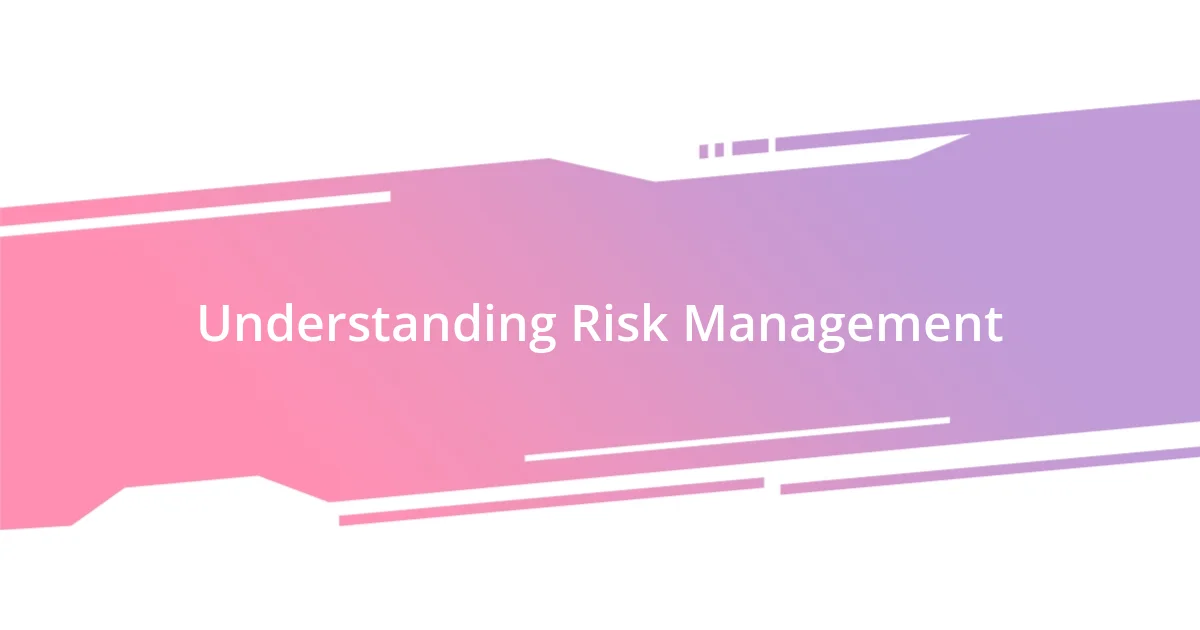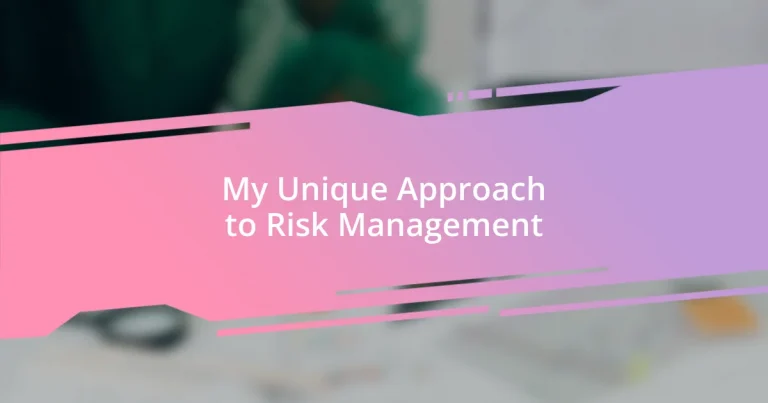Key takeaways:
- Proactive risk management is essential; fostering a culture of collective awareness and emotional intelligence strengthens team resilience in navigating challenges.
- Utilizing diverse risk identification methods, such as team brainstorming and maintaining a risk register, enhances awareness and prioritization of potential risks.
- Continuous monitoring and adaptation to changing risk environments, supported by technology and stakeholder engagement, are crucial for effective risk management strategies.

Understanding Risk Management
Risk management, at its core, is about identifying potential obstacles and developing strategies to navigate them. I remember a project early in my career where we encountered a significant budget overrun. It taught me that understanding risk isn’t just about avoiding problems; it’s about planning for the unexpected and being prepared to adapt when things don’t go as planned.
When I think about risk management, I often wonder: how proactive are we really in our approach? For instance, in my experience, conducting regular risk assessments has been invaluable. It’s not just a checkbox on a project plan; rather, it’s about fostering a culture where everyone feels encouraged to spot possible risks and contribute to solutions. This collective awareness can turn potential disasters into manageable challenges.
Moreover, emotional intelligence plays a surprisingly significant role in risk management. I learned this during a tense meeting where my team was faced with a looming deadline. By empathizing with their concerns and encouraging open communication, we not only identified our risks but also fostered a sense of collective responsibility. This connection made us stronger and more resilient when challenges arose. Have you ever experienced a moment when understanding someone’s perspective shifted your approach to a problem? Those moments are where true learning happens.

Identifying Potential Risks
To identify potential risks effectively, I rely on a blend of intuition and structured analysis. One approach I find particularly helpful is brainstorming sessions with my team. I recall one project where a simple two-hour discussion surfaced numerous risks we hadn’t previously considered, from resource shortages to external market fluctuations. It reminded me that embracing diverse perspectives can illuminate blind spots in our risk awareness.
In addition to group discussions, I encourage creating a risk register – a living document that helps track and evaluate risks as they arise. When I first implemented this practice, it felt laborious, but soon the team saw its value. It became our go-to reference point, enabling us to prioritize risks and tackle them with informed strategies. This shift in how we visualized risks truly changed our dynamic; it transformed risk management from a daunting task into a manageable process.
Finally, let’s not overlook the power of gut feelings. I remember encountering a hunch an employee had about potential software malfunctions. Initially dismissed, the concern turned out to be valid, leading us to implement vital testing phases. Experiences like this underline the importance of not just relying on data but also valuing the insights that come from our teams. Trusting our instincts can often steer us in the direction of key risk identification.
| Risk Identification Method | Description |
|---|---|
| Team Brainstorming | A collaborative approach to surface diverse potential risks. |
| Risk Register | A living document to track and prioritize identified risks. |
| Intuition | Trusting gut feelings and team insights can lead to significant risk identification. |

Assessing Risk Impact and Probability
Assessing the impact and probability of risks is crucial to effective risk management. I vividly remember a project where we faced a potential supply chain disruption. By thoroughly evaluating the probability of that disruption occurring and estimating its impact on our deliverables, we were able to devise a contingency plan that ultimately saved us time and resources. This experience reinforced my belief that a clear assessment can guide strategic decisions and priorities.
Here are a few key considerations I keep in mind when assessing risk impact and probability:
- Define the Risk Clearly: Pinpoint exactly what the risk entails to understand the nuances of its impact.
- Evaluate Likelihood: Use data and historical context to gauge how likely a risk is to occur.
- Analyze Consequences: Assess how different aspects of the project may be affected if the risk materializes—this includes timelines, costs, and team morale.
- Mitigation Strategies: Identify and implement proactive measures to lessen the risk’s impact before it becomes an issue.
- Continuous Monitoring: Risks evolve; I always ensure I review assessments periodically to adapt to changing conditions.
When I reflect on these factors, I realize that risk assessment is as much about collaboration as it is about analysis. Gathering diverse viewpoints during risk evaluation can highlight potential scenarios I might overlook. Each person brings unique experiences and insights, effectively enriching the overall assessment process.

Developing a Risk Response Plan
Developing a risk response plan is where strategy meets action. I recall a time when we faced a major project delivery deadline, and a key vendor suddenly went out of business. To tackle this unforeseen challenge, we quickly convened to devise a plan. It involved finding alternative suppliers while also building a buffer into our schedule. By addressing the risks proactively, we not only met the deadline but also strengthened our supplier relationships. Isn’t it fascinating how a challenging situation can reveal new opportunities?
Being specific about the types of responses we want to implement is key. I often utilize strategies like avoidance, mitigation, and transfer, depending on the scenario. For example, in a tech project where data security was a concern, we chose to invest in enhanced cybersecurity measures rather than risk a setback. It’s a decision I still feel proud of because it ensured our clients’ data remained safe and solidified their trust in us. How often do we have the chance to turn a risk into a point of strength?
I also place significant emphasis on communicating our risk response plan clearly to all stakeholders. I remember a project where our risk response strategy was outlined in a simple, engaging presentation. It resonated with the team; they could visualize the steps we would take if risks materialized. This clarity reduced anxiety and fostered a united front, enabling everyone to move forward confidently. Wouldn’t you agree that transparency can transform uncertainty into a shared mission?

Implementing Risk Mitigation Strategies
Implementing risk mitigation strategies requires a collaborative approach that brings all team members together. I once worked on a cross-departmental initiative where each team contributed their unique insights to identify risks. The energy in the room was palpable, as brainstorming together not only highlighted potential pitfalls but also fostered innovative solutions we could implement swiftly. Have you ever experienced the thrill of collective problem-solving?
When it comes to action, I prioritize the implementation of risk mitigation techniques that resonate with me personally. One time, I spearheaded an initiative aimed at reducing the risk of equipment failure on a critical project. We set up a preventive maintenance schedule with regular check-ins, and the result was astonishing—it significantly lowered unplanned downtime. It felt rewarding to bring proactive measures into play, transforming potential crises into smoothly running processes. Isn’t it amazing how a simple change can yield such impactful results?
Another vital aspect of effective risk mitigation is never to overlook the importance of training and empowerment. I recall facilitating a workshop where we trained employees on recognizing and responding to potential risks in their daily tasks. The enthusiasm was infectious, and I saw firsthand how empowered individuals can foster a culture of vigilance and resilience. When team members feel accountable, they become key players in our risk strategy—don’t you think it’s crucial to cultivate that sense of ownership?

Monitoring and Reviewing Risks
Monitoring and reviewing risks is an ongoing process in my unique approach to risk management. For instance, during a project review meeting, I recall how we revisited previously identified risks and assessed their current relevance. It was enlightening to discover that some risks had diminished while others had escalated. This adaptive perspective has always empowered my teams to stay agile and responsive. Have you ever noticed how regularly checking in on risks can shift your entire outlook on project stability?
I find that maintaining a risk register is essential for effective monitoring. In my experience, this living document becomes a project’s heartbeat, providing a clear snapshot of what needs attention. Once, while managing a large-scale transition, our team used the register to track an emerging risk associated with regulatory changes. Regular updates and discussions around this document allowed us to pivot our strategy effectively. Isn’t it fascinating how a structured approach can provide clarity in complex situations?
Lastly, engaging stakeholders in the review process adds immense value. I always involve team members and clients in risk discussions, as their diverse perspectives can unveil insights that I might have overlooked. During a recent project, I invited feedback on our risk assessments, and several stakeholders highlighted potential risks related to user adoption that hadn’t crossed my mind. This collective intelligence not only enriched our understanding but also reinforced the significance of collaboration. Don’t you agree that involving others creates a more comprehensive safety net?

Adapting to Changing Risk Environments
Adapting to fluctuating risk environments is crucial in today’s fast-paced world. I can recall a time when an unexpected market shift completely altered our project scope. As a team, we had to pivot quickly, reassessing risks associated with budget constraints and reallocation of resources. It was a whirlwind moment, but it taught me the importance of staying flexible and being ready to embrace change. Have you ever experienced that rush of needing to adapt on the fly?
In my own journey, embracing technology has played a significant role in adapting to these changes. I remember when our project management tool introduced real-time analytics. It was a game changer, allowing us to monitor new risks as they emerged. This shift not only streamlined our responses but also enhanced collaboration, providing immediate visibility on how changes impacted our collective efforts. Doesn’t it feel empowering when you have helpful tools at your fingertips?
Moreover, cultivating a mindset of continuous learning has been instrumental in my approach. For instance, I attended a conference focused on emerging risks, which opened my eyes to trends I hadn’t considered before. Sharing these insights with my team sparked discussions that helped us fine-tune our strategies moving forward. I believe that staying informed is not just about knowledge but also about fostering a culture where everyone feels encouraged to share what they learn. Isn’t it fascinating how a simple shift in perspective can revolutionize our approach to risk management?














